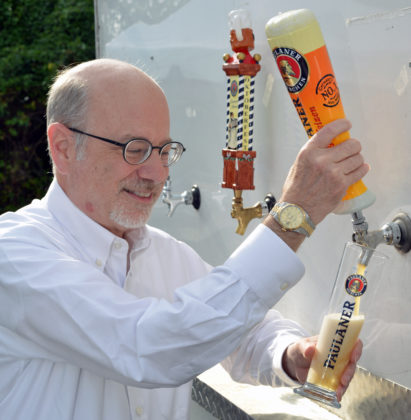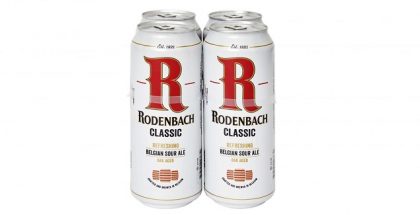5 Questions With…Paulaner USA CEO, Steve Hauser
The rapid contortion and contraction of today’s U.S. craft beer markets present opportunities for both brewers young and old to capitalize on the American passion for high-quality beer. While the OGs of American craft beer like Sierra Nevada and Anchor Brewing continue to churn out quality beer, there’s an even older subset of international breweries looking to make their own inroads beyond their traditional Oktoberfest imports.
Paulaner USA made a splash in the American craft beer market last year when they announced that they were importing two of the German brewing powerhouse’s most prized beers, Paulaner Hefeweizen and Original Munich Lager, to the States. Now, Paulaner USA is adding to their portfolio of quality German beers with the announcement that they are importing the first offering from their sister brewery, Hacker-Pschorr, whose Weisse beer is now available in the U.S. market in 16.9 oz. cans. The move is another clean indicator that the centuries-old brewing powerhouses of Paulaner and Hacker-Pschorr are committed to providing American drinkers with a variety of well-made, easy-drinking beers—in their preferred packaging vessel of cans.
To find out more about Hacker-Pschorr’s recent announcement, we asked Steve Hauser, President and CEO of Paulaner USA, five questions ranging from why they chose to release the flagship Weisse in cans throughout the U.S., to what comes next for the historic brand in this market. Here’s what he said...

What makes the American audience appealing to a historic German brewery like Hacker-Pschorr?
“Well, we are really lucky to have some great history on Hacker-Pschorr. The beer is considered by many Americans of German heritage to be the most authentic German beer in the US. This is because it was first served in the U.S. at the Philadelphia Centennial Celebration (1876) where it was declared the best beer in America by an act of Congress.
When you combine that with its over 600 year brewing history, 2nd- and 3rd-generation German Americans can link back to their family roots in a very enjoyable moment. Besides, this makes for great bar room trivia!”
Your first beer be available in the U.S. is your Weissbier in cans. How do you approach marketing a style/beer terminology that might be unfamiliar to the U.S. consumer? What are the pros and cons?
“Got to tip our hat to the domestic craft brewers here. They have done a great job helping to sophisticate the American beer drinkers understanding of styles and brewing techniques. By offering American drinkers their local interpretations of classic styles like Weisse/Wheat beer, craft brewers sparked curiosity among their drinkers. We believe that got them to try styles and names that they might not have been familiar with.”
American beer drinkers tend to prefer cans while your traditional German audience prefers bottles. Why do you think this is and how has your packaging strategy evolved to meet the needs of each audience?
“Germans prefer bottles because they are cheaper in Germany. Why? Returnable refillable glass. It’s better for the environment and costs the brewers less.
So why cans? Packaging needs to help the drinker make the choice in the moment. What a drinker may chose on a Friday night in the pub is different than what they chose at the club on Saturday night. While draft and bottles might serve both these moments, clearly on Saturday afternoon at the beach or a backyard picnic or barbeque, we wanted to give drinker’s an easy choice in those moments.”
What brewing segment of the U.S. beer market do you view as your biggest competition for sales? What advantages do you think you have? What about vulnerabilities?
“We are all about bringing great beer to more consumers. So, anyone making a great beer in our eyes should be celebrated, no matter where it comes from. That does not mean we will readily give up the opportunity to sell! But, if we are going to truly grow our brand, we must demonstrate to craft beer drinkers that our classic Hacker Pschorr Weisse and other brands in our portfolio are the standards by which many craft brewers based their own recipes. What is the old saying; ‘Imitation is the sincerest form of flattery?’
We are flattered, but we still think customers are missing out on the classic experience and we hope our can package will expose more of them to what a German Weissbier is all about. We appreciate that many brewers today find the Reinheitsgebot a quaint tradition, however we are proud of the discipline that it requires. Our creativity is based in honoring that tradition to yield beers that are among the finest of their style.”
What does a successful launch look like for you? What opportunities do you see to expand even further in the U.S. market?
“The most important aspect for any new beer is convincing distributors of the opportunity. Many are refusing new SKUs due to the size of their portfolios. We don’t think this is necessarily fair as we demonstrated last year the power of our portfolio with the Paulaner brands posting a +5% depletion gain. We believe that by not working with us to bring in strategically developed new offerings like Hacker-Pschorr Weisse in cans, many distributors are missing a significant opportunity. And amazingly many still resist.
So, first and foremost 100% distributor distribution is critical as without it, consumers cannot discover our product. Once we achieve that first level of distribution, we are confident that retail depletion velocity will be sufficient enough to create a sustainable brand franchise.”
Feature image courtesy of Hacker-Pschorr








Submit a Comment